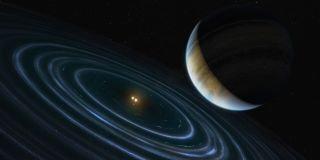
This image shows an exoplanet named HD 106906 b with the mass of 11 Jupiters (Source: NASA, ESA, and M. Kormesser)
336 light-years away, scientists have spotted a giant exoplanet orbiting a binary system — which could provide clues to unraveling the mystery of our own galaxy.
At the edge of the solar system, farther than Neptune, there is a group of icy objects, the "overseas objects", which move in unimaginable ways. Some astronomers believe that these objects are influenced by the gravitational pull of an unobserved planet (planet ninth) that orbits very far. Others see this effect as being influenced by the gravitational pull of many asteroids, rather than a large planet.
According to Hubble Space Telescope researchers, the newly discovered exoplanet, called HD 106906 b, may help us explain how a planet can hover at the edge of the solar system without disengaging.
The planet is 11 times the size of Jupiter and was first discovered in 2013. However, its orbit remains a mystery to this day. The exoplanet's distance from its central binary is staggering — more than 730 times the distance between the Sun and the Earth. Because the gravitational pull of the star is so weak at this distance, the planet is moving so slowly that it only rotates once in 15,000 years.
The Hubble Space Telescope allowed researchers to observe the orbit of a planet that moves as slowly as a snail crawls. They found that the orbit was stretched long, and that it was tilted at a strange angle, and that it was also outside the disk of debris surrounding the star (similar to our Kuiper Belt).
Meiji Nguyen, an astronomer at the University of California, Berkeley, the head of the study, said in a note: "This tilt is strange. If we look at our solar system, we can see that all the planets are roughly on the same plane. For example, it would be strange if Jupiter's orbit differed by 30 degrees from the plane in which other planets orbited. How hd 106906 b's orbit became so sloping raises a series of scientific questions."
The possible orbit (dotted ellipse) of the exoplanet HD 106906 b observed by Hubble, which is far from its host star (Source: NASA, ESA)
Scientists think it could be the case: The exoplanet formed very close to its star, even less than the sun-Earth distance. Over time, gravitational pull brings the extrasynalist closer to its host star. However, the complex gravitational pull of the binary system will not allow them to collide, but will throw the exoplanet into a new orbit in the vastness of space. This new orbit has the potential to take the planet out of the star's gravitational influence, but in due course, another star approaches the alien system, stabilizing the exoplanet's orbit and preventing it from deorbiting.
If a ninth planet existed, something similar might have happened in our solar system. The planet may have formed near the sun, but was thrown by Jupiter's gravitational pull toward the edge of the solar system, at which point a passing star pushed Planet Nine away from Jupiter's influence, keeping it from completely detaching from the galaxy and fixing itself in the solar system. The Gaia program, a project of the European Space Agency, is working to construct a 3D map of the Milky Way over time that will help study the identification of stellar interactions during the early days of the formation of the solar system.
Paul Callas, a researcher at the University of California, Berkeley, stated: "It's as if we have a time machine that allows us to go back 4.6 billion years to the solar system and see what might happen to our young, lively solar system, when matter collides and reassembles in chaos."
The new exoplanet offers a hint to astronomers in their search for Planet Nine. If Planet Nine is similar to HD 106906 b, it should also have a strangely sloping orbit. Astronomers will also study the planet HD 1069096 b more closely to try to understand how and exactly it formed.
Related knowledge
Planet Nine, also known as Planet Nine, is the name given to a hypothetical neptune exoplanet that might exist on the outer boundary of the solar system. It is speculated that Planet Nine could be a super-Earth at least twice the size of Earth. While there is no current evidence to prove that the planet does exist, most scientists believe that if it were, it would reasonably explain the unusual orbits of several extra-Neptune bodies in the Cooper Belt at the edge of the solar system and the Otter Cloud.
BY: Stephanie Pappas - Live Science Contributor
FY: Aphelion
If there is any infringement of the relevant content, please contact the author to delete it after the work is published
Please also obtain authorization to reprint, and pay attention to maintaining completeness and indicating source